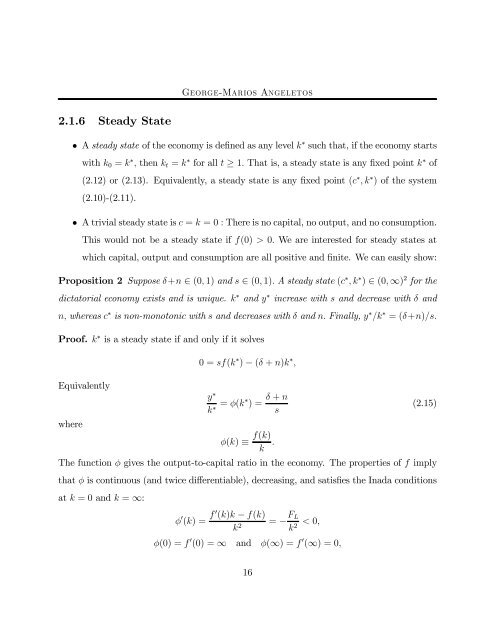14.451 Lecture Notes Economic Growth
14.451 Lecture Notes Economic Growth
14.451 Lecture Notes Economic Growth
You also want an ePaper? Increase the reach of your titles
YUMPU automatically turns print PDFs into web optimized ePapers that Google loves.
2.1.6 Steady State<br />
George-Marios Angeletos<br />
• A steady state of the economy is defined as any level k ∗ such that, if the economy starts<br />
with k0 = k ∗ , then kt = k ∗ for all t ≥ 1. That is, a steady state is any fixed point k ∗ of<br />
(2.12) or (2.13). Equivalently, a steady state is any fixed point (c ∗ ,k ∗ ) of the system<br />
(2.10)-(2.11).<br />
• A trivial steady state is c = k =0:There is no capital, no output, and no consumption.<br />
This would not be a steady state if f(0) > 0. We are interested for steady states at<br />
which capital, output and consumption are all positive and finite. We can easily show:<br />
Proposition 2 Suppose δ+n ∈ (0, 1) and s ∈ (0, 1). A steady state (c ∗ ,k ∗ ) ∈ (0, ∞) 2 for the<br />
dictatorial economy exists and is unique. k ∗ and y ∗ increase with s and decrease with δ and<br />
n, whereas c ∗ is non-monotonic with s and decreases with δ and n. Finally, y ∗ /k ∗ =(δ+n)/s.<br />
Proof. k ∗ is a steady state if and only if it solves<br />
Equivalently<br />
where<br />
0=sf(k ∗ ) − (δ + n)k ∗ ,<br />
y ∗<br />
k ∗ = φ(k∗ )=<br />
δ + n<br />
s<br />
(2.15)<br />
φ(k) ≡ f(k)<br />
k .<br />
The function φ gives the output-to-capital ratio in the economy. The properties of f imply<br />
that φ is continuous (and twice differentiable), decreasing, and satisfies the Inada conditions<br />
at k =0and k = ∞:<br />
φ 0 (k) = f 0 (k)k − f(k)<br />
k 2<br />
= − FL<br />
< 0,<br />
k2 φ(0) = f 0 (0) = ∞ and φ(∞) =f 0 (∞) =0,<br />
16

















